As a beauty industry professional, it’s essential to understand the nuances between various makeup products. Clients come to you for advice, and being able to provide them with accurate information is vital to building trust and loyalty. One of the most common questions you may receive is about the difference between pressed powder and powder foundation. But what exactly is the difference between these two products?
Pressed powder is a convenient and easy-to-use product that sets makeup, controls shine, and provides a smooth finish. On the other hand, powder foundation is a heavier product that serves as a base for makeup and offers more coverage than pressed powder. Knowing the difference between these two products can help you provide the best advice for your clients.
1. The Basics of Pressed Powder and Powder Foundation
We know that pressed powder and powder foundation are two different types of makeup products that are used to create a smooth, even complexion. Pressed powder is typically used to set liquid or cream foundation, to absorb excess oil, and to minimize the appearance of pores. Powder foundation, on the other hand, is typically used by those with oily skin, as it absorbs excess oil and provides a matte finish.
Pressed powder and powder foundation are essential makeup products that can help to control shine, minimize the appearance of pores, and create a smooth, even complexion. They are also great for touch-ups throughout the day, particularly for those with oily skin. Using these products can help to set the makeup and extend its wear time.
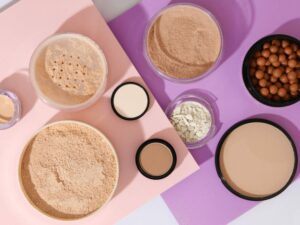
2. Pressed Powder
Pressed powder is a type of cosmetic powder that comes in a compact form. It is typically used to set foundation, control shine, and provide a smooth, matte finish to the skin. Pressed powder can also be used on its own as a light coverage foundation.
Types of Pressed Powder
Here are some common types of pressed powder with brief definitions:
Translucent Powder
A colorless or sheer powder that is used to set makeup, control shine, and create a smooth, matte finish on the skin.
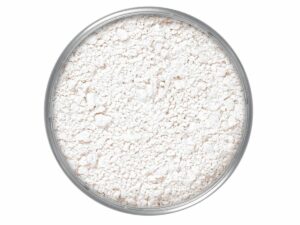
Setting Powder
A powder that is applied after foundation or concealer to help lock in the makeup and prevent it from sliding or melting off the skin throughout the day.
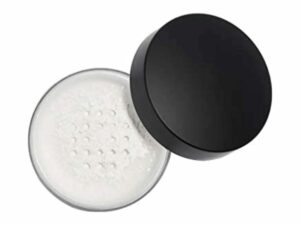
Mineral Powder
A type of pressed powder that contains natural, mineral-based ingredients such as titanium dioxide and zinc oxide. It is often marketed as a “natural” alternative to traditional makeup.
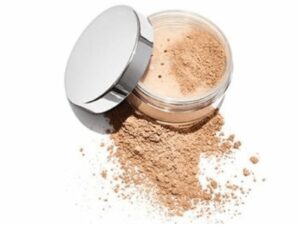
Compact Powder
A pressed powder that comes in a compact form and is convenient for touch-ups throughout the day. It typically provides light to medium coverage and is often used as a quick and easy way to even out the complexion.
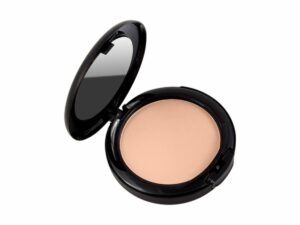
Matte Powder
A type of pressed powder that provides a complete matte finish without any shine. It can be used to set foundation, control oil, and reduce the appearance of pores.
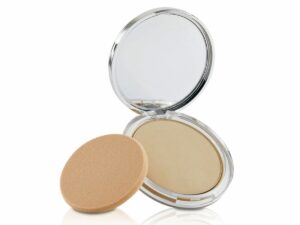
Application Techniques
Here are some common application techniques for pressed powder:
Brush Application
One of the most common ways to apply pressed powder is with a brush. Use a fluffy brush to sweep the powder across the face, focusing on areas where it tends to get oily or shiny. I suggest starting from the center of the face and working the way outward for an even application.
Sponge Application
Another popular way to apply pressed powder is with a sponge. Press the sponge into the powder and then gently dab it onto the face, starting from the center and working the way out. This method can provide more coverage than a brush application, but make sure to blend well for a natural look.
Powder Puff Application
A powder puff can also be used to apply pressed powder. Gently press the puff onto the powder and then apply it to the face in a pressing motion. This technique can provide more coverage and is especially useful for touch-ups throughout the day.
Baking Application
For a more intense, long-lasting finish, the baking technique can be used. After applying concealer and foundation, use a damp sponge to press a generous amount of powder onto the areas that tend to get oily. Leave the powder on for several minutes, allowing it to absorb the excess oils, and then dust away the excess with a brush. This technique can provide a flawless, airbrushed finish but is not necessary for everyday use.
Regardless of the application technique, it’s important to apply pressed powder lightly and blend well for a natural finish. Avoid using too much powder, as this can create a cakey or heavy look.
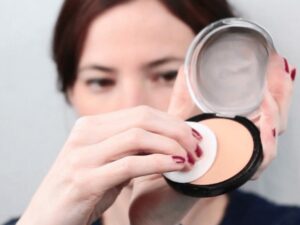
Choosing the Right Shade
Choosing the right shade of pressed powder is important to ensure a natural, seamless finish. Here are some tips for selecting the right shade:
Determine the Skin Tone
Start by identifying the skin tone, which can be categorized as fair, light, medium, tan, or deep. This will help you narrow down the range of shades to choose from.
Undertones
Next, consider the skin’s undertone. Undertones can be warm, cool, or neutral, and this will impact which shades will look best on you. Look at the veins on the wrist to determine the undertone. If they appear blue or purple, you have cool undertones. If they appear green, you have warm undertones. If they’re a mix of both, you have neutral undertones.
Consider Your Foundation Shade
If you wear foundation, choose a pressed powder shade that matches or is slightly lighter than the foundation. This will ensure that the overall complexion looks even and natural.
Test the Shade in Natural Light
It’s important to test the shade in natural light, as artificial lighting can distort the color. Swipe a small amount of powder on the jawline or neck and step outside to see how it looks in natural light.
Experiment With Different Formulas
Different formulas of pressed powder can have varying levels of pigmentation, so you may need to experiment with a few different shades to find the right match.
Overall, it’s important to take time and test the shade of pressed powder in different lighting to ensure a perfect match. Additionally, some brands may offer color-matching services or samples to help you find the right shade.

Benefits of Pressed Powder
Pressed powder can offer several benefits for the skin, including:
Oil Control
One of the main benefits of pressed powder is its ability to control oil and shine on the skin. It can help absorb excess oil, leaving a matte finish that lasts throughout the day.
Long-Lasting
Pressed powder can help set makeup, ensuring it lasts longer and stays in place. It’s a great way to extend the wear of the foundation and keep the makeup looking fresh all day.
Blurs Imperfections
Pressed powder can also help to blur the appearance of fine lines, wrinkles, and other imperfections on the skin, providing a smoother and more even complexion.
Provides Sun Protection
Some pressed powders contain ingredients like zinc oxide or titanium dioxide that can provide sun protection, making them a great addition to the daily skincare routine.
Overall, pressed powder is a versatile and useful product that can benefit a wide range of skin types and makeup preferences.

3. Powder Foundation
Powder foundation is a type of makeup product that provides coverage and a matte finish to the skin. It’s typically made of finely milled powders, such as talc, and can be applied with a brush or sponge. Powder foundation is a popular option for those who prefer a lightweight and natural-looking finish.
Types of Powder Foundation
Here are the most common types of powder foundation with a brief definition of each:
Loose Powder Foundation
A powder foundation that is not compressed, and typically comes in a jar with a sifter. It’s applied with a brush, and can provide light to medium coverage, depending on the formula.
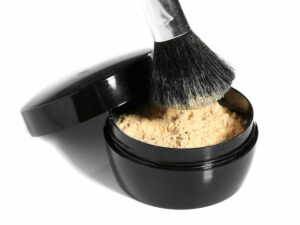
Pressed Powder Foundation
A powder foundation that is compressed into a compact form. It’s applied with a brush or sponge, and can provide light to medium coverage, depending on the formula.
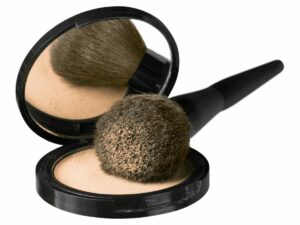
Tinted Moisturizer Powder Foundation
A powder foundation that is infused with moisturizing ingredients, like hyaluronic acid or glycerin, and offers light coverage. It’s a popular option for those who want a natural, dewy finish.
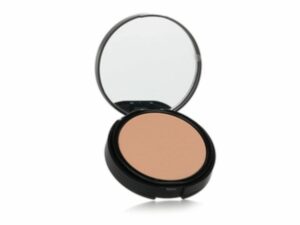
Baked Powder Foundation
This type of powder foundation is created by baking the powder in the oven, resulting in a creamy texture that provides buildable coverage. It can be applied with a brush or sponge.
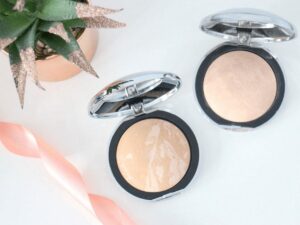
Cushion Powder Foundation
This type of powder foundation comes in a compact with a sponge applicator. The sponge is soaked in a liquid formula that dries down to a powder finish, providing buildable coverage.
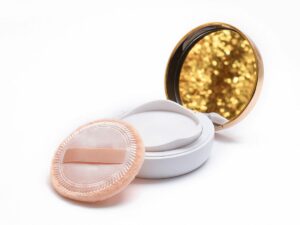
Dual Finish Powder Foundation
This type of powder foundation can be used wet or dry, providing a range of coverage from sheer to full. It can be applied with a brush or sponge, and is ideal for those who want versatility in their makeup routine
Each type of powder foundation has its own unique features and benefits, so it’s important to choose the one that works best for the skin type and desired level of coverage.
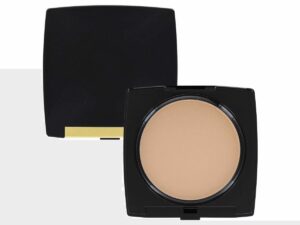
Application Techniques
Here are some common application techniques for powder foundation:
Brush Application
The most common way to apply powder foundation is with a brush. Use a large, fluffy brush to sweep the powder across the face, focusing on areas where you need coverage. Start from the center of your face and work your way outward for an even application.
Sponge Application
A sponge can also be used to apply powder foundation. Dip the sponge into the powder and then press it onto the face, starting from the center and working your way out. This method can provide more coverage than a brush application, but make sure to blend well for a natural look.
Powder Puff Application
A powder puff can also be used to apply powder foundation. Gently press the puff into the powder and then apply it to the face in a pressing motion. This technique can provide more coverage and is especially useful for touch-ups throughout the day.
Wet Application
Some powder foundations can be applied wet for a more intense, full coverage finish. Wet the brush or sponge before dipping it into the powder and then apply it to the face in a pressing motion. This technique can provide a flawless finish, but be careful not to use too much product, as it can look heavy and cakey.
Layering Technique
If anyone need more coverage in certain areas, they can layer powder foundation on top of itself. Apply a thin layer of powder foundation, wait a few seconds for it to set, and then apply another thin layer in the areas that need more coverage. This technique can provide natural-looking, buildable coverage.
Regardless of the application technique, it’s important to apply powder foundation lightly and blend well for a natural finish. Avoid using too much powder, as this can create a cakey or heavy look.
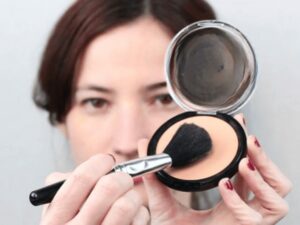
Choosing the Right Shade
Choosing the right shade of powder foundation can be tricky, but here are some tips to help you find the best match for the skin:
Determine the Skin Tone
The first step is to determine your skin tone. Are they have fair, light, medium, or deep skintone? Do they have warm or cool undertones? This can help narrow down the range of shades that will work for them.
Test in Natural Light
It’s important to test powder foundation in natural light, as indoor lighting can be deceiving. I suggest applying a small amount of powder to the jawline and checking the color in natural light to ensure it matches the skin tone.
Consider the Undertones
When choosing a shade of powder foundation, consider the undertones. If anyone has warm undertones, look for shades with yellow or golden undertones. If anyone has cool undertones, look for shades with pink or neutral undertones.
Consider the Skin Type
Different types of powder foundation may be better suited for different skin types. For example, if anyone has dry skin, they may want to choose a hydrating or luminous powder foundation, while if anyone has oily skin, they may want a matte or oil-absorbing formula.
Don’t Forget About Seasonal Changes
The skin tone may change throughout the year due to sun exposure, so it’s important to reassess the shade choice every so often.
Remember, finding the right shade of powder foundation can take some trial and error, but it’s worth the effort to achieve a flawless and natural-looking finish.
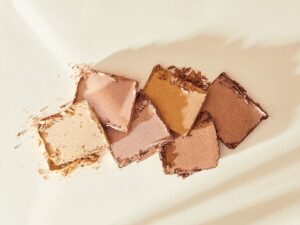
Benefits of Powder Foundation
Powder foundation has several benefits that make it a popular item in many makeup routines. Here are some of the benefits of using powder foundation:
Provides Natural-Looking Finish
Powder foundation can provide a lightweight, natural-looking finish that is great for those who prefer a more subtle makeup look.
Quick and Easy Application
Powder foundation can be applied quickly and easily with a brush or sponge, making it a convenient option for those who are short on time.
Controls Shine
Many powder foundations are formulated to absorb excess oil and reduce shine, making them especially useful for those with oily or combination skin.
Long-Lasting
Powder foundation is often long-lasting and can provide coverage for several hours without the need for touch-ups.
Provides Sun Protection
Many powder foundations are formulated with SPF, offering an extra layer of sun protection to the skin.
Good for Sensitive Skin
Powder foundation can be a good option for those with sensitive skin, as it’s often free of ingredients that can cause irritation, such as fragrances or preservatives.
Buildable Coverage
Powder foundation can be applied in layers to achieve the desired level of coverage, from light to full coverage.
Overall, powder foundation is a versatile and useful product that can benefit a wide range of skin types and makeup preferences.

4. Pressed Powder vs Powder Foundation
Pressed Powder and Powder Foundation are two types of makeup products that have similarities and differences. Here’s a comparison of the two:
Coverage
Pressed powder generally provides sheer to light coverage, while powder foundation can provide light to full coverage, depending on the formula and application technique.
Texture
Pressed powder typically has a fine and silky texture, while powder foundation can range from silky to matte texture. I suggest trying out both products to see which texture works best for the skin type and desired finish.
Formula
Pressed powder is typically made with finely milled powders, like talc, and may contain additional ingredients like silicone, while powder foundation formulas may include additional pigments, emollients, and binders to provide coverage and adheres to the skin.
Purpose
Pressed powder is primarily used for setting makeup, controlling shine, and providing a matte finish. Powder foundation, on the other hand, can provide coverage, even out skin tone, and create a smooth, even appearance.
Placement
Pressed powder is typically used in specific areas of the face to reduce shine, such as the T-zone or under the eyes. Powder foundation, however, is applied all over the face to even out skin tone and provide coverage.
Difference in Application
Pressed powder is usually applied with a brush to lightly dust powder on top of the skin. Powder foundation can be applied with a brush, sponge, or powder puff for more coverage.
Overall, pressed powder and powder foundation are both makeup products that can provide coverage and finish to the skin, but differ in texture, formula, purpose, and application.
5. 6 Factors to Consider When Choosing Between Pressed Powder and Powder Foundation
The global market for pressed powder and powder foundation was valued at $8.2 billion in 2020, and it is expected to reach $10.5 billion by 2028, growing at a CAGR of 3.4% from 2021 to 2028 according to Grand View Research. With the increasing demand for cosmetic products, here are some factors to consider to help you choose between pressed powder and powder foundation:
| Factors to Consider |
Pressed Powder |
Powder Foundation |
| Skin Type |
Better for dry skin; won’t dry out skin. |
Better for oily skin; provides fuller coverage and controls oil. |
| Coverage |
Light coverage; ideal for touch-ups throughout the day. |
Fuller coverage; provides more coverage than pressed powder. |
| Finish |
Matte finish. |
Natural-looking finish. |
| Application |
Applied with a brush or sponge. |
Applied with a brush or sponge for lighter coverage or with a damp sponge for fuller coverage. |
| Ingredients |
Check ingredients for safety and effectiveness. Look for products certified by reputable organizations. |
Check ingredients for safety and effectiveness. Look for products certified by reputable organizations. |
| Purpose |
Good for quick touch-ups throughout the day. |
Good for primary foundation. |
#1 Skin Type
Consider the skin type before selecting either pressed powder or powder foundation. For example, if anyone has oily skin, powder foundation might be more suitable as it provides fuller coverage and controls oil. On the other hand, if anyone has dry skin, pressed powder might be a better option as it is lighter and won’t dry out the skin.
#2 Coverage
Pressed powder provides light coverage and is ideal for touch-ups throughout the day. If anyone wants fuller coverage, they should opt for powder foundation.
#3 Finish
Pressed powder gives a more matte finish, while powder foundation gives a more natural-looking finish. I suggest considering the skin type and the occasion for which it will be wearing makeup.
#4 Application
Pressed powder is typically applied with a brush or sponge, while powder foundation can be applied with a brush or sponge for lighter coverage, or with a damp sponge for fuller coverage.
#5 Ingredients
Check the ingredients of the product before selecting either pressed powder or powder foundation to ensure safety and effectiveness. For instance, you can check if the product is certified by reputable organizations such as the FDA or the EWG . These organizations evaluate the safety and effectiveness of cosmetic products and can provide helpful information for consumers.
#6 Purpose
Consider the purpose of the product. If anyone is looking for a quick touch-up throughout the day, pressed powder might be more convenient. However, if anyone wants to use the product as the primary foundation, powder foundation might be a better option.
Ultimately, the decision to choose between pressed powder and powder foundation will depend on personal preference, skin type, and desired outcome. It is essential to test the product before purchasing to ensure it works well with the skin type and provides the desired coverage and finish.
If you’re looking for reliable cosmetic manufacturers, Nako Cosmetic is a great choice. Our products are made using only the finest ingredients, and we take great care to ensure that they are safe, effective, and free from harmful chemicals. Our team of experienced professionals is committed to providing exceptional customer service and delivering products that exceed your expectations. Contact us today to learn more.
Dive Deeper Into Our Resources
Looking for more diverse product options? Browse through our handpicked selections:
Still haven’t found what you’re looking for? Don’t hesitate to contact us. We’re available around the clock to assist you.
6. Conclusion
In conclusion, while both pressed powder and powder foundation serve the purpose of setting makeup and providing a matte finish, they have different formulations and functions. Ultimately, the choice between pressed powder and powder foundation comes down to personal preference and the specific needs of the skin.
I hope this clarifies the difference between these two types of makeup products and helps users make an informed decision when selecting the best option for their needs. If you still have any questions, contact us at Nako Cosmetic. Our team of beauty experts can help you choose the right product for your business needs.

















